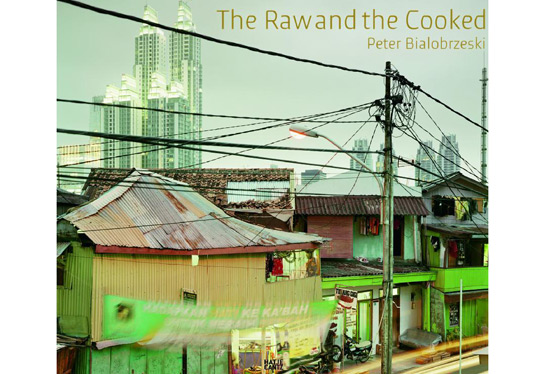Review: The Raw and the Cooked by Peter Bialobrzeski

Peter Bialobrzeski has been traveling across Asia (and some other countries) for many years now, taking photographs of countries in transition. The first well-known book to emerge from these travels was Neon Tigers. This new book, The Raw and the Cooked is a follow-up of sorts, another book dealing with, in the photographer’s words, “today’s rapidly burgeoning, constantly changing cities” (quoted from the book’s epilogue). (more)
The book follows a linear trajectory of sorts. The very first image is a photograph of a ramshackle, slum hut on a beach in Manila. The last image shows the towering facades of spic-and-span apartment buildings in Singapore. There is a multitude of possible narratives here, and you’re free to pick the one you like.
The technical decisions the artist made - the use of a certain type of camera, a certain time of day, etc. - gives many of these photographs a very seductive quality, while neatly avoiding the tropes of advertizing or architectural photography. There are people in these photographs, many people, but often enough they become a blur - things move too fast for the slow camera (echoing, of course, Louis Daguerre’s 1838/9 Boulevard du Temple). Cars are reduced to lines of colour (red or yellow), and even people blend into each other - where they’re not standing still.
This often leads to interesting results. On page 74, people, cars and other vehicles are waiting at red traffic lights. Since one barely notices the traffic that is allowed to move (there is a blur in the photograph’s lower left corner) everybody looks frozen as if suspended. The photograph on the opposite page makes those waiting for the green light look like spectators of a somewhat absurd spectacle. On the previous page (73) there is a lone woman overlooking the scene (and, since this is a diptych, the spread essentially) from her balcony, looking down on a vast world. What is this world we have created?
I’m stuck by the visual complexity of some of the photographs. Page 33 shows people selling their wares (mostly shoes and plastic goods) on some street in Dhaka. The photograph is organized around a lone pole from which strings with little flags emanate into, it seems, every possible direction. What initially might look like a confusing, crazy mess actually turns into a rather well-organized scene, where there is less chaos than initially thought. And even if you can’t get past that chaos… Well, this is life. Maybe not in your part of the world, but somewhere else.
The Raw and the Cooked thus requires time and patience, since there is a lot to be explored in many of the photographs. You don’t have to explore - on their own the photographs are powerful. But there is more… Those who like to complain about how “fine art” photobooks are too insular, too much made for some small in-crowd might want to look at books like this: You don’t have to be an insider to enjoy it (much like, let’s face it, you don’t have to be a photobook insider to enjoy many others). But once you take the time, you start seeing a lot of details, and your level of appreciation changes. And that’s really what photography is all about: The enjoyment to be had from looking, and the enjoyment to be had from seeing a little bit more, or something a little bit different every time you come back.
The Raw and the Cooked, photographs by Peter Bialobrzeski, essay by Peter Lindhorst, 160 pages, Hatje Cantz, 2012
(find my presentation of the book here)